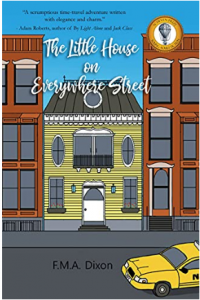In 2019, the Acheven Book Prize for Young Adult Fiction found its inaugural winner in Malcolm Dixon and his novel The Little House on Everywhere Street.
The prize included publication of the winning manuscript, and now in 2022, Malcolm is seeing his years of hard work and dedication pay off in a huge way. We chatted to Malcolm about his inspirations and how he found the time to write an award-winning novel while also working full-time at the University of Kent.
How did you first come up with the idea of using time travel focused around a house?
In truth, the idea that the house would have three doors/exits that each opened out into a different city – London, Paris, and New York – came first; the time-travel notion came around as a consequence of imagining how such a house might work in reality (well, in fictional reality).
But the three doors idea was first and central to the whole novel. It made me ask, who could live in a house where, if you go out the front door, you’d be in New York, the side door in Paris and the back door in London? How would it affect them? How would it work? And what could go wrong?
When you begin to think about the answer to the latter question, the answer turns out to be quite a lot could go wrong. Quite a lot indeed. Ask the Redmaynes, the family that lives in the house. Mr Redmayne is still trying to decide if residing in such an unusual house is a blessing or a curse. Takes him all three volumes in the series and several madcap time-travelling escapades with the likes of William Shakespeare, Charles Dickens, and Sir Isaac Newton for him to finally make up his mind. Which is it? Can’t say. He’s sworn me to secrecy. He also wants me to say that he’s not responsible for what happens to Sir Isaac Newton in Book 3. That’s NOT responsible. NOT.
Did the historic landscape of Canterbury influence the setting at all?
Not in Book I (The Little House on Everywhere Street), although Faversham does get a mention in that volume, in 1603. However, it turns out in Book II (Return to Everywhere Street) that Mr Redmayne’s deceased father, Rufus, had been renting the same room in a Canterbury inn for 900 years; and that when Mr Redmayne finds this out and visits it in Book 3 (The Fabulous Redmaynes), he ends up being pursued through the Cathedral by the ill-mannered Time-Police (who disapprove strongly of the Redmaynes and their time-travelling house, very strongly), and he makes his escape though a time-portal secreted in the Cathedral’s Dark Entry. This all happens in 2008 and I should know because I was there, having moved to the city in 2001. Folks, I saw it all.
How did you balance writing a novel with working full-time?
When you want to do something enough, you’ll do it. I wrote The Little House on Everywhere Street at weekends and edited it during the week in the University’s Templeman Library, maybe adding lines here and there as I went along. This was a routine that I’ve been following at Kent for full-on twenty years. As I say, if you want it enough, you’ll do it.
Where did you hear about the Acheven Prize, and what prompted you to enter?
I probably heard about the prize through the New Pages website, which is dedicated to sharing such writing opportunities. I have written and published a lot of short fiction in the likes of Aesthetica and The London Magazine and these stories have been short-listed for other national prizes in the UK. But the Acheven is the only prize that I’ve been fortunate enough to win.
Is there a book you wish you’d written?
The Great Gatsby. One of my first true loves. I first read it as a teenager in 1978 on a Greyhound bus, and I can virtually quote it verbatim. Fitzgerald wrote such beautiful prose. See the passage in Gatsby about the train ride home from the East Coast to Minnesota at Christmastime and passing through the ‘lost Swede towns’ in the snow. I was lucky enough to live and study in Minnesota for three years as a young man and that passage still gives me the shivers every time I read it. So gorgeous.
Who are your literary inspirations?
Fitzgerald, Salinger, Tolstoy, Malcolm Lowry, Terry Pratchett, and a 1920s American comedic writer called Robert Benchley. Love Benchley. (Everybody look him up – worth it.)
What is your favourite part of writing a story?
Editing, I think. Writing is hard, and never harder than when trying to get it down on the page in black and white for the first time. Very rarely does it come out perfect and those rare moments are to be savoured and can’t be topped. But editing is where you get to spin the straw every day into something that might look, at least at first glance, from a respectable distance, a bit like gold. Inspiration has its moments, but editing is where you get to polish up the shiny nuggets.
Do you have plans to write more novels?
Book 2 of the trilogy is done, edited four times line by line, and is good to go. Book 3 is a complete first draft but it’s what I’ll be spending my weekends polishing up for the foreseeable future. After that, well, I’ll see what comes long.




